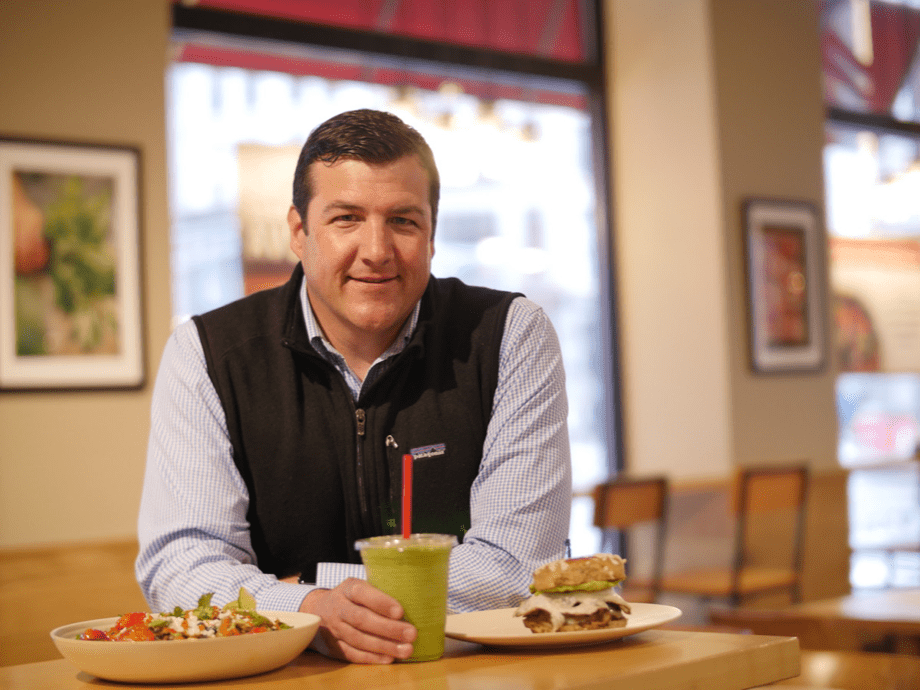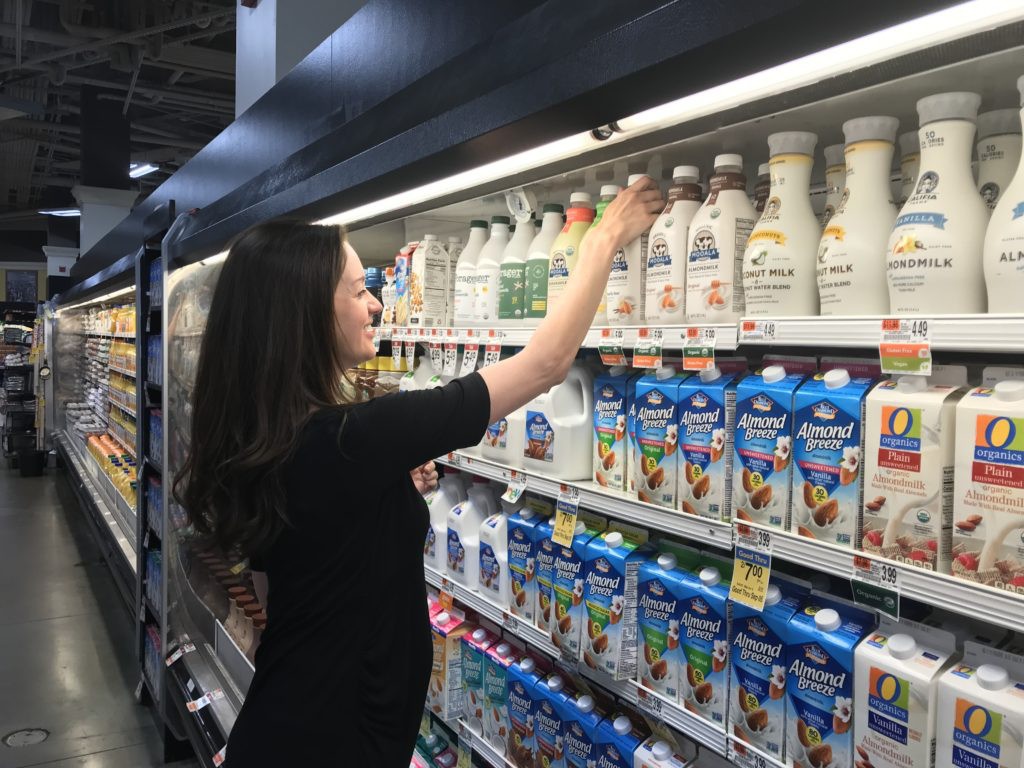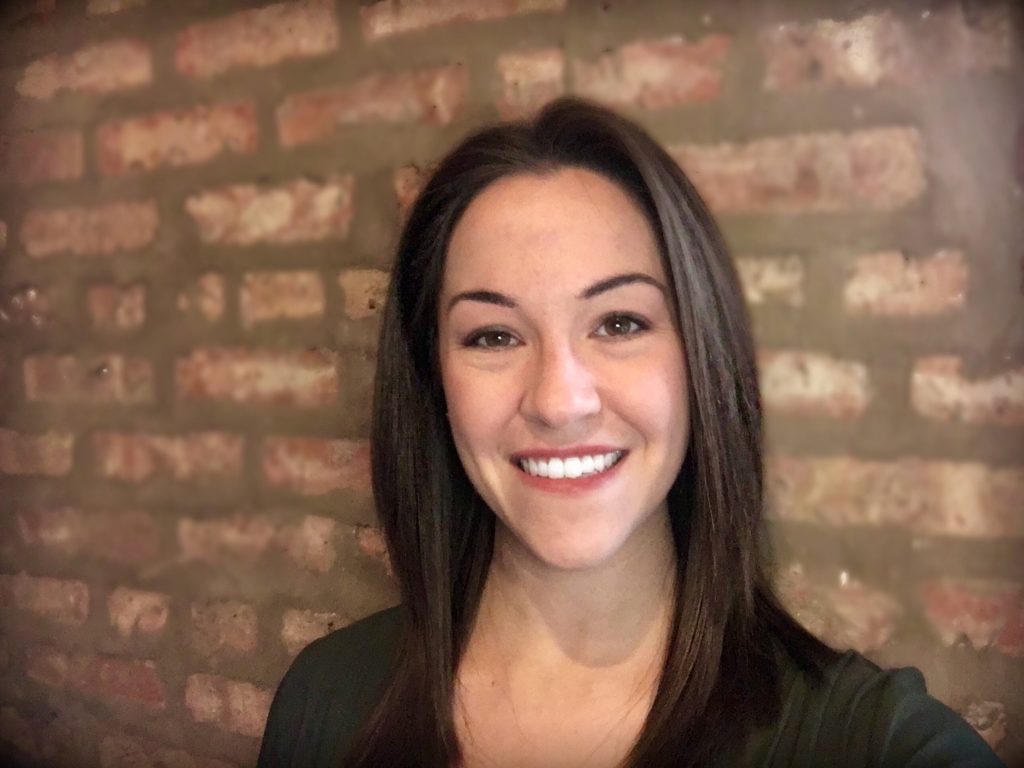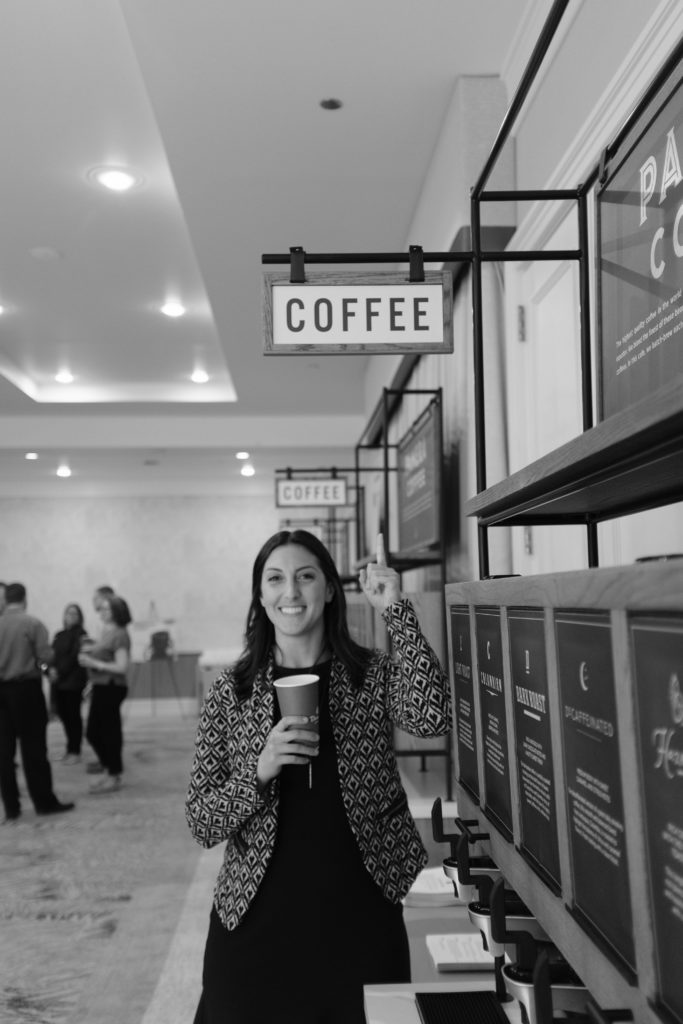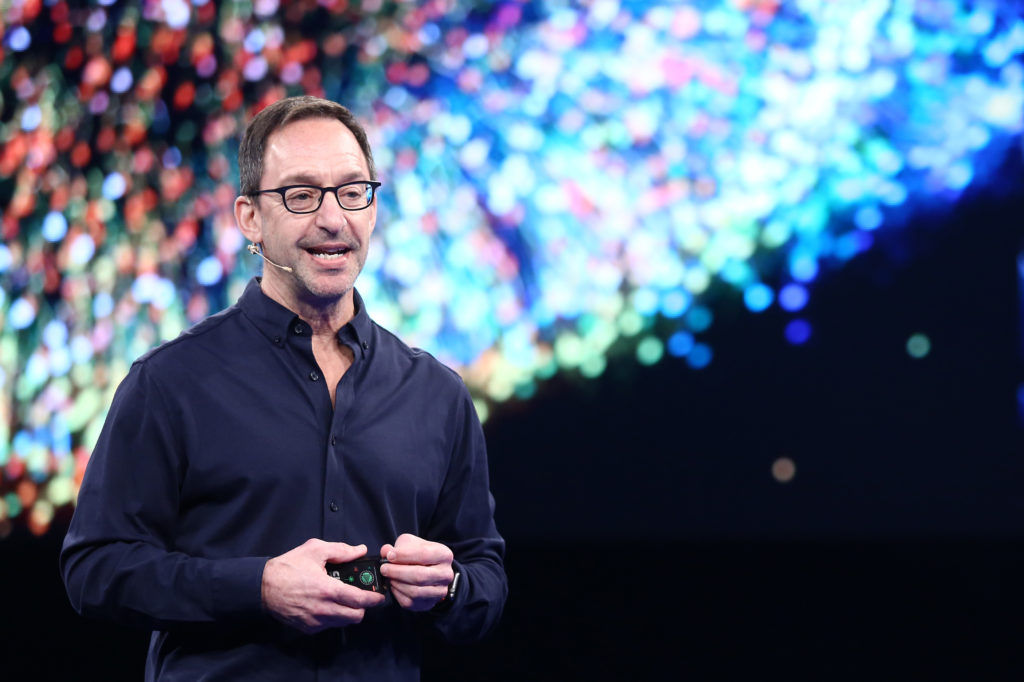We all have that someone we admire from afar – who juggles family, career and passions while maintaining a strong sense of self.
Enter Jenn George Caliguri, Global Director of Public Relations and Influencer Marketing for Headspace. Before she worked for the digital health company that provides guided meditation training and mindfulness, we PR’ed together at Cone Communications and I’ve always recalled her energetic & adventurous spirit. With two kids in tow (we rescheduled this interview because she went into labor #priorities), she and her husband manage to rock a dual career household & plenty of international travel. We recently sat down to chat about both life’s ‘ohm’ and ‘omg’ moments.
Her top tip: “Your career isn’t a ladder, it’s a lattice.”
This interview was conducted Boston to LA via Facetime & was condensed and edited for clarity.
Headspace, with heart
Jenn! Congrats on adorable baby Madeline and thanks for taking the time to chat .
Happy to! I’m currently in the middle of a very generous 4-month maternity leave. Hopefully she stays calm. [We Facetimed with Jenn’s adorable newborn in her lap].
Headspace – tell us about it.
Headspace is a digital health brand focused on meditation and mindfulness. With 1200 hours of content in the app itself, we just surpassed 56 million members in 190 countries. It’s funny: app-based meditation is relatively new, but we often forget that meditation is not. It’s been around thousands of years.
Andy, our co-founder and the voice in the app, knows the history of meditation better than anyone. After university in London, he spent a decade in Southeast Asia and Tibet studying meditation and becoming an ordained Buddhist monk. He returned to the UK with a desire to share what he’d learned at scale. There, he met our co-founder Rich Pierson, a burned-out ad executive, and the two of them built Headspace into the incredible platform it is today.
Headspace has helped take meditation mainstream.
In a sense, yes. Meditation is a time-honored tradition and ancient practice but it also boasts numerous health benefits backed by modern science.
In fact, Headspace is committed to advancing mindfulness and meditation through clinically-validated research on its own product. Our in-house science team has partnered with Harvard, Stanford, Carnegie Mellon and USC, among others, to initiate some of the most rigorous studies ever conducted on meditation. Translation: we’ve completed or are in process on more than 70 studies related to the clinical efficacy of the Headspace app on health outcomes. Headspace has been shown to have favorable outcomes including reduced stress, improved focus, increased compassion, and decreased aggression.
Science is clearly one of the pillars of your PR efforts, what are the others?
If you’re familiar with Headspace, you probably know us for our consumer content but we also have an enterprise segment, Headspace for Work. We offer our products to companies and their employees as benefits, and have relationships with some of the world’s most recognized brands: Apple, Amazon and Nike.
Sport and education are other important areas for us. We’re the NBA’s exclusive meditation & mental training partner and on the education front, we offer free access to K-12 teachers and school administrators in select countries through our Headspace for Educators program. Ultimately, we’re working to meet people where they are, whether that’s in their home, the office, on the field, or in the classroom.
What about global expansion?
We’ve have millions of English-language global users but in 2019, we launched Germany and France in their native languages. Given today’s socio-economic and geopolitical turmoil, the world is becoming an increasingly stressful place so we’re committed to making our content more accessible in our users’ native languages.
Tell us about Headspace’s culture.
The culture is probably exactly what you’d expect! Our co-founders’ vision of making the world a happier, healthier place permeates the organization. All employees are encouraged to meditate, so we offer twice-per-day meditation sessions: 10am and 3 pm. We also have dedicated meditation rooms where you can sit in silence any time (i.e. after a stressful commute).
Bigger picture, whenever we interview potential candidates, we assess them on our three core values to determine culture fit: Curious Mind, Courageous Heart and Selfless Drive.
Did you meditate before joining Headspace or has it become a part of your daily routine since joining?
I’ve been meditating for six years. When I first moved to LA, I read a book called “The Morning Miracle” by Hal Elrod that advocated for a daily, morning ritual: a mix of affirmations, journaling and meditation. It’s tough with a newborn, but I try to spend an hour by myself around 4 or 5am and do four things: journal, read affirmations, meditate for about 10-20 minutes and then work out.
I also try to meditate at our 10am group session and sometimes at night. It sounds like a lot but if I do all three, it’s only about 30 minutes total and it makes a huge difference in my productivity, focus and presence.
You mentioned meditating when you’re stressed – do people tend to meditate reactively vs. proactively?
I view daily meditation like a multivitamin, a way to prevent and deal with stressors. My husband, however, approaches meditation differently. He won’t meditate for weeks or months but when an event triggers stress, he plugs into Headspace to decompress.
Stepping Back / Career History
Let’s take a step back & reflect on what brought you to where you are today.
I went to Syracuse for undergrad where I also ran cross country (Go Orange!). While in college, I interned in Boston where I went on to work after graduation. First, Schneider Associates, where we launched new products for brands like Baskin-Robbins and NECCO Confectionery Company (the maker of the iconic Valentine’s Day candy hearts). I then moved on to Cone Communications where I worked in Brand Marketing and Cause Branding for clients such as Nestle, and Deloitte.
Part of what spurred my interest in Cause Branding was my first solo, international trip to Kenya. I spent two weeks at a school for rescued girls and I can’t underscore enough how this brief experience changed my perspective on work and life. I remember riding the T, Boston’s subway system, home from the airport and feeling an energy shift. In rural Kenya, there was an obvious material poverty but a wealth of spirit. On the T that day, I felt the exact opposite. I knew I wanted to continue volunteering and eventually, have a global angle to my career.
Tell us about the decision to attend business school.
I attended Boston University for an MBA and to gain international experience. BU offered a 1.5 year accelerated program that kicked off with the class consulting small & medium-sized Chinese businesses on how to enter the U.S. market. I absolutely loved Shanghai – if I spoke Mandarin, I would live there! Unfortunately, the only things I learned to say were, “Please take me to this address” and “I’d like the red wine, please.”
Upon graduation, what sparked the move from Boston to California?
My now husband, Patrick. We started dating right before I went to China – talk about long distance!
Once back in the US, we dated cross-country for about two years – and built up a lot of Delta Skymiles – before I graduated and landed a job in LA. It was a whirlwind: I graduated on a Saturday, moved across the country on a Sunday and started my new job on Monday.
You landed at The Wonderful Company. Did you aim to continue in PR or did you aim for a career transition?
I went to business school thinking I wanted to transition to Brand Management but having spent most of my time at an agency, wasn’t sure how I’d move in-house. I discovered The Wonderful Company, who owns and sells FIJI Water, POM Wonderful, Wonderful Pistachios, Teleflora and JUSTIN wines. The company is amazing in that it’s completely vertically integrated – they own the entire supply chain that powers the products – and the Communications team operated as an in-house agency supporting all brands. To me, that was ideal: I was able to use my PR, CSR and change management skillset to make and implement comms & business recommendations.
How did you transition that experience to Murad?
After three years at Wonderful, I moved to Murad as Head of PR, Social Media & Influencer Marketing and absolutely loved it. Like a lot of people, I struggled with acne in my teen years and actually used Murad to help control flare-ups. So it was a personal joy for me to help evangelize the efficacy of the Murad line of skincare.
One of my favorite parts of working at Murad was the opportunity to work with the founder, Dr. Howard Murad. It’s hard to describe him because he’s so much more than a dermatologist. The youngest of six children born to Iraqis immigrants, he put himself through college, pharmacy school and medical school before starting his own company at 50 and ultimately, reinventing himself as a champion of Modern Wellness. He’s a true visionary.
While at Murad, I helped launch 10+ new products per year with our retail partners, built Murad’s influencer programming, and led the brand’s first purpose campaign called “Eyes Up.” The campaign had a dual purpose: encouraging real life human connections outside of social media and educating the consumer on the very real health impact of our devices. There’s research demonstrating that blue light from our devices can actually go even deeper into our skin than sunlight can and can even lead to phenomenons like tech neck, so it was a relevant program on a few fronts.
And then came Headspace.
In making the decision to move to tech and join Headspace, I leaned on a former client who once told me: “Don’t think of your career as a ladder, think of it as a lattice.” In other words, don’t continually look for the next job title or opportunity to climb; think about how your next role will round-out your skills and professional toolbox. Since joining Headspace in 2018, I couldn’t have asked for a more exciting, enjoyable place to be.
Is there a theme can you thread throughout your career moves?
The real thread throughout my career has been two-fold: working for impassioned, founder-led companies and advancing the conversation around health. As a runner and a mama, health and wellness is super important to me; it makes my job much more meaningful and my work more impactful when I can see how my contributions make a difference.
Road Warrior
Switching gears – you’re in a dual career household with a lot of business travel on both sides. How do you and your partner manage?
It’s tricky. As a working mother, I’ve realized there’s no such thing as balance. My husband and I prioritize each others’ careers, though usually not at the same time. Having honest, upfront conversations early and often means that we engage in a give-and-take dynamic versus feeling like one partner always has to be the ‘breadwinner.’
Of course, it’s easy to say and more challenging to put into practice. It takes deliberate and orchestrated prioritization. We typically sit down with a giant calendar and map out our respective commitments to ensure no overlap. Patrick’s a freelance producer and he travels a lot for business as well. Just a few months ago, I was on a red eye back from Europe and that same afternoon, Patrick was leaving to shoot American Idol auditions in Idaho so we had to do a childcare hand-off. There was just a short window between our flights, so thank goodness there were no delays! It’s certainly not always easy, but this give-and-take allows us to be there for our kids and nurture our individual careers.
One constant amid the chaos is your love for travel. You love it, I love it and we prioritize it – how do you make set aside time for one of your passions?
A lot of people book big international trips a year or more in advance. We tend to book things somewhat last minute to ensure it aligns with our work schedules.
As a result, I try not to over plan or become too rigid about a particular destination. For example, Patrick was working in Peru right after Jack was born and I flew down for a long weekend (leaving the baby with my mom and dad). Peru wasn’t necessarily on the top of my travel list, but I found myself loving every minute. It was incredible.
To me, the beauty of traveling is the adventure itself and removing myself from a routine. So I find myself saying ‘yes’ to a lot of unplanned opportunities.
What’s your travel philosophy? For example, do you maximize by tying business & personal travel together?
I try to add on a day or two to work travel for myself – there’s something so introspective and freeing about seeing a new place on your own. You meet the most interesting people and get to see things through your own lens.
Last year, I was in London for work and hopped on a train to Edinburgh for the weekend and loved it. We just went back as a family so I could share it with them. So, if I had to articulate my travel philosophy, it’s: Just say yes, and don’t overthink it.
That’s funny because being in PR, you’re both a thinker & a planner.
I find that folks who have a trip all planned out end up viewing it like a checklist vs. an experience. Some people love checking items off a list but that’s my day-to-day life, so I like to travel with a more ‘go with the flow’ mindset. You never know where some unexpected encounter might take you!
I love that school of thought. Sounds like we share a similar travel philosophy. Finally, traveling with kids – doesn’t sound like you guys will be slowing down at all?
No, we won’t be slowing down. Patrick and I talked about this a lot before our two-year old son Jack was born because travel is so important to us, personally and professionally. We viewed it like this: first, the kids are joining our family, not the other way around. A lot of people try to tell you that life has to dramatically change when you have kids, but we’ve tried hard to find a middle ground.
The other piece is that we don’t want our kids to have a myopic view of the world. Traveling gives us an opportunity to show Jack and Madeleine first-hand that, yes, differences exist in the world but that in and of itself isn’t something to fear. We can and should celebrate differences as something that adds color and beauty to our lives.

